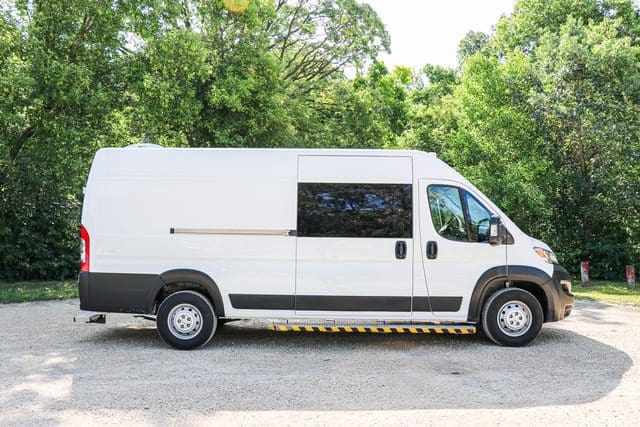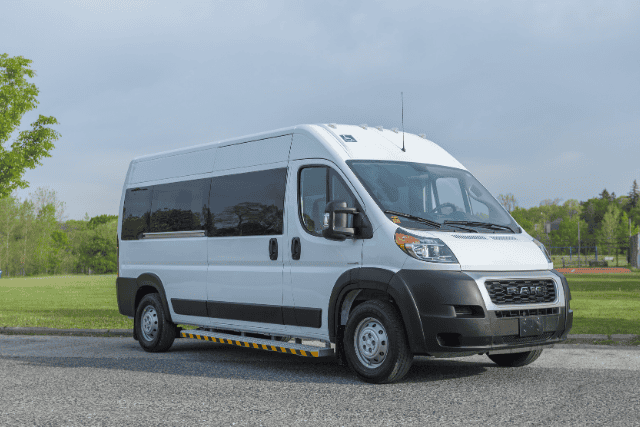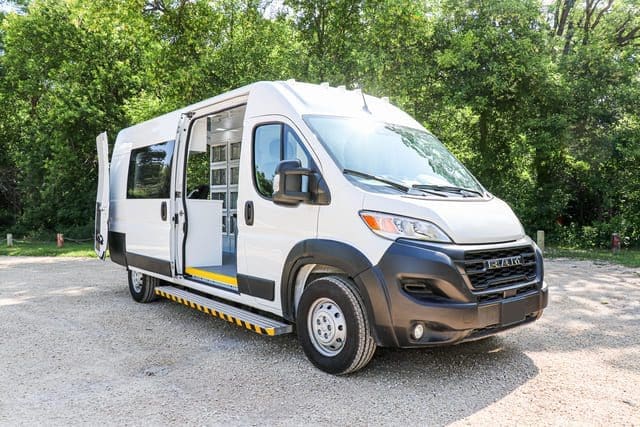Is your organization currently in the midst of starting a mobile medical program? When you get to the point of starting to research manufacturers, one of the things you’ll likely hear about is the wheelbase on mobile medical vehicles. Choosing the vehicle with the wrong wheelbase can affect maneuverability, costs, parking, and the weight distribution of your vehicle.
At AVAN Mobility, we manufacture mobile medical vehicles with a wheelbase of 159”. We’ve been crafting these vehicles for organizations all over North America for over 10 years. With more mobile medical units being manufactured and used, more lives are saved.
In this article, you’ll learn about the wheelbase of mobile medical vehicles. We’ll start off talking about what the wheelbase is, and then highlight some of the problems you can potentially run into with a longer wheelbase. After reading, you’ll have a clearer understanding of whether a mobile medical unit with a shorter or longer wheelbase is suitable for your needs.
What is the wheelbase on mobile medical vehicles?
The wheelbase on mobile medical vehicles is how far apart the front and rear wheels are. The wheelbase plays an important role in how the vehicle moves and stays steady.
Why does the wheelbase matter?
Stability: The right wheelbase improves the stability of a vehicle, especially on bumpy roads or tight turns. This makes it safer for patients and equipment inside the mobile medical unit.
Versatility: The wheelbase affects how well the vehicle can turn in small spaces, like narrow streets or crowded areas. A vehicle with a shorter wheelbase makes it easier to take tight turns and drive in cramped spaces.
Weight balance: The length of the wheelbase affects how the vehicle’s weight is spread out. This impacts how the vehicle handles and stays on the road. A vehicle with better handling and balance prevents expensive medical equipment from moving around inside the van.
What impact does the wheelbase have on mobile medical programs?
The wheelbase impacts how easily your mobile medical vehicle can reach people in remote and urban areas. A vehicle with a shorter wheelbase is easier to navigate in remote communities and busy cities.
The wheelbase also impacts the comfort levels of the vehicle. A steady ride from a solid wheelbase means patients will feel more comfortable. This is important for keeping them relaxed and safe while getting medical care on the go, especially if you’re transporting them to the hospital in a stretcher van.
In the next sections, you’ll learn about the top 5 problems with a longer wheelbase on mobile medical vehicles.
Top 5 problems with a longer wheelbase on mobile medical vehicles
Let’s take a closer look at some of the problems associated with a longer wheelbase on mobile medical units.
1. Maneuverability
A longer wheelbase on mobile medical vehicles makes it tougher for them to move around smoothly, especially in tight spaces.
Why it’s an issue:
Getting through tight areas: Mobile medical units often need to go through narrow streets, crowded cities, or remote areas with rough roads. But with a longer wheelbase, it’s harder to steer through these tight spots. This can slow down your team reaching patients who urgently need help.
City navigation: In cities where streets are narrow, a longer wheelbase makes it tricky to drive in traffic and find areas where medical help is needed. This can make it tough to provide healthcare on time, and that can end up hurting how well your mobile medical program works.
Rural challenges: Roads aren’t always smooth in rural areas of the U.S. A longer wheelbase can make it even harder to drive on these roads. This means some people in rural communities won’t be able to get medical attention because the vehicle can’t move as freely.
Emergencies: Time is of the essence when there’s an emergency. A longer wheelbase can slow down how fast your mobile medical unit can get to the emergency site and delay urgent help for those who are hurt or sick.
2. Parking challenges

Having a longer wheelbase on mobile medical vehicles makes parking tougher than it needs to be. This affects how smoothly these units can give healthcare.
Why it’s an issue:
Limited parking options: Mobile medical units with longer wheelbases struggle to fit into regular parking spots. This can mean delays in reaching patients or setting up clinics.
Urban hurdles: In cities like San Diego where parking is already hard to find, a longer wheelbase makes it even harder. This can slow down getting to patients and the longer vehicles might even block off traffic in some areas altogether.
Accessibility issues: Longer wheelbases can also make it tough for people to get medical help. Think about someone with mobility issues. If they have to walk a fair distance to your mobile clinic because it’s parked so far away, they might not even bother with it.
Delays in operations: Spending time looking for parking or squeezing into tight spots is time-consuming. This can slow down how quickly your medical team works and will stop your team from helping as many people as it can.
3. Increased fuel consumption
Higher fuel consumption is another problem caused by having a longer wheelbase on mobile medical vehicles.
Why it’s an issue:
Increased weight: When a vehicle has a longer wheelbase, it usually weighs more. This means it needs more fuel to run. This can be a problem for your mobile medical program’s budget. It’ll take money away that could’ve been spent on patient care and other important things.
Less efficient: Longer wheelbases will make your mobile medical unit less efficient, especially in cities or in states with lots of hills. In cities, you’re always stopping and starting. You’ll need to stop for fuel more often and it can get frustrating.
4. Reduced stability on uneven terrain
A longer wheelbase can make the vehicle feel unsteady on rural roads.
Why it’s an issue:
Stability: When it comes to gravel roads, potholes, sharp turns, sudden starts, and bumps, longer vehicles are on the tippy side. This can be a big worry for your medical team and the patients inside. If you’ve ever been inside a long school bus and gone over bumps, you’ll know how it feels.
Patient discomfort: When the vehicle isn’t stable, it can make patients feel uneasy during the ride. If you’re transporting patients to a hospital, the constant bouncing or swaying could make them uncomfortable.
5. Vehicles with longer wheelbases cost more
The last problem related to longer wheelbases on mobile medical vehicles is the financial aspect.
Why it’s an issue:
Increased costs: Mobile medical vehicles with longer wheelbases often cost more to purchase and use. This can make it more difficult for your program to afford.
Maintenance: Longer wheelbases can make parts of the vehicle wear out faster. This can have a negative impact on your program’s annual budget.
Insurance costs more: Vehicles with longer wheelbases typically have higher insurance costs because there is more of the vehicle to insure. This adds to the overall cost of running mobile medical programs.
Driver training and licensing: Using longer-wheelbase vehicles might require drivers to get special training. Paying for this training can add to the costs of your program. If you’re purchasing a mobile medical RV that’s over 40 feet in length or over 26,000 lbs, an RV safety course or commercial driver’s license is required.
Your next steps after these wheelbase insights

You came to this article to learn more about the longer wheelbase on mobile medical vehicles. Now that you know all about the problems associated with it, we encourage you to take things a step further and look at the following articles comparing different vehicles with a short and long wheelbase.
The shorter wheelbase on our mobile medical vans at AVAN Mobility allows organizations to reach more people and save more lives all over the U.S. without facing some of the problems discussed in this article. Connect with a commercial mobility expert to learn how organizations like yours are reaching more people and saving more lives all over the U.S. without facing some of the problems discussed in this article.





